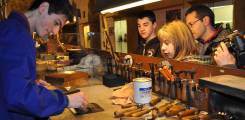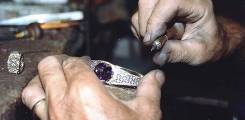This is a tour designed for travelers who wish to scratch a little more under the surface of the city, to get an idea of Florentine artisans’ production that has made Florence capital of handicraft. The Florentine tradition of producing handcrafted goods is centuries old and remains one of the cornerstones of Florence’s artistic and social history today, as much as it was in the times of the trade guilds. Since medieval times this has been a city of “botteghe”, (small artisans’ workshops), and this tradition continues still today. Florentine leather workers, silversmiths, shoe-manufacturers and hat-makers have long produced handmade goods for kings and queens, princes and nobility, working in the very heart of the town.
Visit to a Florentine Mosaic workshop
Our exploration of Florentine handicraft production starts in one of the few workshops where, still today, skilled craftsmen continue the “Florentine mosaic” tradition. It all started at the end of the 16th century when Ferdinand I de’ Medici, founded a workshop for the crafting of semi-precious stones. The inlay or “Commesso” (from the Latin expression cum mittere, put together) consists of the insertion of pieces of semi-precious stones of different sizes, shapes and colours into a stone slab which has been carved in such a way to allow the perfectly precise placement of all the pieces.This art reached levels of excellence and attracted admiration from all over Europe. The Florentine dukes sent these artistic creations as gifts to the crowned heads of Europe whom they wanted to impress. This unique type of art is still carried on today and it’s the fruit of hard working and precise technicians, who amaze and seduce the observer with their “painting of stones”: the artist creates subjects inspired from reality, choosing the right hues that nature offers through the different stones.
Visit to a Florentine stationary paper workshop
We continue our tour to see a demonstration of how “marbled paper” is produced: this is one of the most suggestive ways of hand decorating paper. Marbleizing paper was probably created in China or Japan and went to the Middle East at the beginning of the 15th Century. It was introduced into Europe in the years following the battle of Lepanto (1571) by Venetian artisans, who began making marbled paper with spot-decoration. In the 18th Century the French “Royal bookbinder” Machet Rouet invented a new decoration technique – so-called «combing» – which is now the best known style. At the end of the 18th Century marbled paper technique arrived in Florence, where it was initially used only for binding books; it then began to be used also for endpapers and covers and as a beautiful covering for many different objects.
Visit to a ceramic shop
From the 15th century Florence can boast a top-rank quality production of ceramic ware. Thanks to the exploitation of the unique blend of earths originating from the neighboring area of Impruneta, Florentine artisans still produce a wide range of terracotta and ceramics. The Dome of our cathedral was probably made of bricks coming from the workshops of the ancestors of the present owner of the shop we visit. Among the fascinating items on display, you find dishes, jars, and splendid reproductions of Renaissance and classic ware. This is the wonderful realm manufactured by the artisans working in Impruneta, who create each piece by hand shaping and hand-turning it on a wheel using a plain lump of refined clay. The molded clay piece is called “in Terra” (green ware) and is placed in the open air for natural drying .When it dries, it assumes a light grey color and it is ready for its first firing in the kiln. It’s during this firing that the piece, now referred to as “Biscotto” (bisque), gets the typical terracotta red color.
Then the terracotta object is placed into a liquid defined “Smalto” (enamel). Once dried ,the artisan proceeds with its decoration . The final step is the second firing: a very delicate process, as it requires great care to avoid scratching .The final firing takes up to 24 hours with more than 12 hours of a constant high heat.
Visit to a goldsmith workshop
The goldsmith’s art traditionally consists in working gold and other precious metals (silver and platinum), often in combination with precious stones, in order to make jewels, ornaments and furnishing, as well as liturgical objects.
All the great civilizations of antiquity (such as the Egyptians, and the Greeks), knew and practiced the goldsmith’s art, reaching outstanding levels of artistic and technical quality, but the Etruscans are universally acknowledged for having been the undisputable masters of this art. In Tuscany, the most ancient goldsmith’s artworks date back only to half of the 14th century. In this period the presence in town of 50 goldsmiths’ workshops is already documented. In the Renaissance, a fascinating part of the goldsmith’s activity consisted in creating garlands (ghirlande) made of gold or silver filigree, as well as hairnets to gather up women’ hair, decorated with pearls or precious stones. (Domenico Bigordi, the first teacher of Michelangelo, as he had practiced this refined art, is still nowadays known with the name of ‘Ghirlandaio). Many of the greatest artist masters of the Renaissance were trained as goldsmiths in their youth: Ghiberti, Brunelleschi, Donatello, and in the 16th century, Cellini. The Medici family, loved and protected this craft and ordered the goldsmiths of Florence to move their shops on the Old Bridge, where we still find them today.
For our tour we selected a place with a unique ,genuine atmosphere: La Casa dell’ Orafo, just a few yards away from Ponte Vecchio , housed in an ancient Medieval tower. Here master goldsmiths have been working for centuries, handing on from one generation to the next, the secrets of their ancient art which reflect the passion, creativity and traditions of their people and land. Here you can have your jewels made by commission, hand-made engravings with names or dates, or seals, heraldic shields, or have your jewels repaired, modified and renovated, mounting of precious stones, filigree works and all the other techniques of the great Florentine tradition made by the most experienced and passionate master goldsmiths.
A visit to a perfume atelier
It won’t be wrong to state that the use of scents date back to the dawn of Man’s history, when he discovered that certain kinds of woods and resins, once burnt, exhaled a pleasant smell. In Egypt, incense, perfumed oils and pills were prepared in special premises annexed to the temples, and some formulas for their preparations have come down to us engraved on their walls. Our ancestors, the Etruscans, also added the use of the broom essence. Great lovers of perfumes were the Romans, who also used them for medicinal purposes. In Medieval Europe the cultivation of essences (called “simples”), mainly used for healing purposes, was often the task of the monks living in monasteries. The golden age for the art of perfume was the 15th and 16th century, thanks to the philosophy of the time, Humanism, which welcomed and celebrated beauty and sensuality. Caterina Sforza, Lucrezia Borgia, Cosimo I Medici among others, adored perfumes and spent fortunes to import rare essences from newly discovered lands. In Florence, the root of the “Iris Fiorentina” was used, and still is today, to produce a very delicate scent. The famous perfume, later to be known as “Eau de Cologne” was created in Florence for the future Queen of France Caterina de’ Medici. She brought to the French Royal Court the passion for perfumes, which later will give birth to the great French perfume industry.
One of the most interesting perfume ateliers of the Italian scene is Flor, owned by Sileno Cheloni, a custom designed perfume atelier, located in the Renaissance palace, Serristori-Corsini, in the historic Santa Croce district. He describes his perfumes as”.. the product of extensive research in rare and precious ingredients, something that mass-produced perfumes and cosmetics do not offer. Our products can be found exclusively in our laboratory/store, and will be never distributed elsewhere because of their characteristics and the concept used for their creation. Flor is specialized in custom –made perfumes and cosmetics, starting with the analysis of the skin and the person as a whole . We don’t have a website, because we like the idea of getting to know our clients personally ,opening slowly for them the doors of our world, without having to pass through virtual windows.”
A visit to a leather workshop
In Florence, the tradition of leatherwork is very ancient, as early as the year 1050 we have documents referring to the activity of “fur sewers”, or furriers, who made winter fur-coated clothes for the rich Florentines. Still nowadays Florence has preserved a most vital and flourishing leather goods industry. Beside the clothing and shoes industry, there is a smaller-scale, hand-made production of leather bound objects, such as books, writing –desk fittings, jewel boxes. In the center of Florence one can still find many small artistic leather workshops, such as the one that we are visiting in our tour.
Here follows the presentation of this most innovative workshop in the words of its owners: “Located in the historic center of Florence, our store offers a large selection of leather articles. All our products are designed and hand-made by ourselves or by local Florentine artisans. Our bags, purses and accessories are made with Italian leather which is vegetable tanned and guaranteed by the seal of the consorzio ’Vera Pelle Italiana’ (Authentic Italian Leather Vegetable Tanned): no chemical treatments which hurt man and the environment are used. We have also researched new materials and procedures that respect the environment and promote the culture of recycling. We match waterproof fabrics in natural colors with rubber of recycled tires that have been treated with mild soap. In this way, each of our bags and purses is created individually, and becomes an unique object with a modern and creative design. Besides our own production we are also the exclusive representatives in Florence for both Cyclus and Goma, innovative brands for men’s and women’s accessories made from recycled inner tubes, for people who want to combine comfort with practicality. We sustain fair trade as a way to contribute to a new way of protecting our world”.
SMELL – The scent of happiness
In a small and warm atelier, hidden in a beautiful courtyard decorated with medicinal plants, our aromatherapeutic expert perfumes will teach you, in 4 hours, all the secrets to make a solid perfume, a perfume that you can always bring with you. The solid perfume is made out of natural essences without chemical additives or preservatives. In these 4 hours (in which you will enjoy a nice coffe break) you will be introduced to the principles of aromatherapy and you will learn the properties of the essencial oils. These botanic perfumes influence our wellness harmonizing our emotional levels. In the workshop you will learn how to recreate the perfume in your house, a perfume that is not just good, but a real therapy scent. Confide in your nose, what you like is what your emotional system craves!














